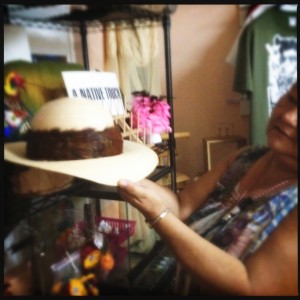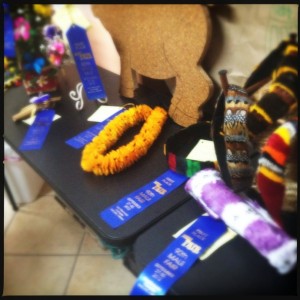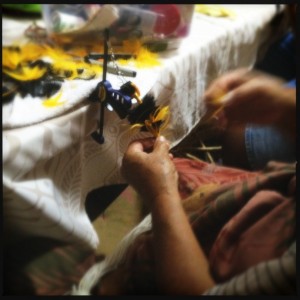Maui Lei Artist Teaches Hands-on History
Vanessa Wolf is a Maui-based writer who never met a sea otter she didn’t like.
By Vanessa Wolf

One of Hanna’s student’s traditional feather lei made with Royal colors and in kamoe style took first place at the Fair. Photo by Vanessa Wolf
Within a few days, most leis have withered into something rather sad-looking.
Not so with the feather-based creations done by Pattie Hanna and her students.
Those students took home nearly a dozen blue ribbons at the 90th annual Maui county fair, it is clear Hanna’s goal is coming to fruition. “What matters to me as a lei maker is passing it on; who came before me and after me is what’s most important.”
Hanna is fifth generation from the Keokea feather lei maker line, although specifics become more and more vague as one goes backwards in the lineage, usually ending with “some lady or guy up in Kula.”
At one time, only Hawaiian royalty were allowed to wear feathers.
However as hula and Hawaiian language was discouraged, the symbolic feather art continued quietly in the countryside and the knowledge survived. Royal lei were banned, but the lei makers adapted the knowledge to other applications. Whether these paniolo (cowboy) artists were intentionally rejecting the new rules or continuing their heritage despite the laws is unknown.
Hanna learned by observing the lei makers there in Keokea where she grew up. “I was taught in the Nana i ka kumu style which is to watch quietly, listen attentively and keep your mouth shut.”

Pattie Hanna displays a prized lei she made from rare purple Mongolian pheasant feathers. Photo by Vanessa Wolf
Once upon a time, the royal birds used for lei were trapped by the members of a male-only guild called po’e hahai manu. One or two feathers was taken from each of the birds – most of which were as small as cardinals and are now extinct – and the bird was then released. The ‘i‘iwi and ‘apapane birds were used for red, ‘o‘o for pale yellow, and mamo for a rich gold color.
In modern times, however, Hanna’s students use full pheasant pelts obtained from local hunters and dyed goose, peacock, and rooster feathers. The dyed feathers come in every color of the rainbow, and Hanna encourages wanton creativity. “There are no rules,” she explains of her teaching style. “I push them to go beyond the perceived boundaries.”
The students learn two primary styles of feather work and lei making. Traditional feather lei were created by cutting the feathers to a uniform size and then attaching them to a central cord base, somewhat akin to tying flies.
Hanna’s co-teacher, Ron Daniels, invented a tool for lei makers, called a Key. The shape of a tiny paddle, Ron tinkered with his invention for a while, “The first ones I made out of bamboo. Then I started cutting them out of plastic with a Sabre saw.”
All the students have since purchased one from Daniels. They are used to measure and are also pivotal in providing an anchor upon which one builds the traditional poepoe (fat and fluffy, like a boa) or kamoe (smooth and rope-like) style leis. This original wili wili (wrapped around and around) style was practiced by the earliest Hawaiians and required no more than feathers and some sort binding material.
The introduction of Christianity also brought needles and thread to the islands, and the Paniolo hatband style took off. By the end of the 1800s, feather hatbands or lei hulu were very popular and men could be seen sporting feather bands around their Panama hats.
Hanna has been teaching for 12 years and estimates she’s taught over 300 people. Student Kevin Pacheco used to do hair, and his eye for color shows. One of his blue-ribbon winning lei hulu – in vibrant layers of magenta and pink – was inspired by a red ti leaf.
Although he began making leis less than a year ago, it has become a passion. “I feel like I’m doing something for my culture,” Pacheco explains.
Several class members began attending Hanna’s class after joining the he Ahahui Kaahumanu Society, which encourages them to learn the art of traditional lei making.

Pattie Hanna’s students kicked booty and took names at this year’s 90th Annual Maui Fair. Photo by Vanessa Wolf.
The weekly class is as much a social gathering as a learning opportunity. “One of the pillars of Hawaii is its people,” Hanna explains. “We always have food. It’s like local families: you always come with something and you never leave empty-handed.”
How long does it take to learn?
“How much patience you got?” Pacheco quips.
A rare opportunity to learn – and perhaps ultimately pass on – a true piece of Hawaiian culture, the class is open to the public at a cost of $25 plus supplies. Join Hanna and her students from 6-8 p.m. on Monday nights at her Wailuku shop, located at 430 Hookahi Street, suite A-5.
Are you a local artist – singer, storyteller, fire dancer, fashion designer, playwright, taiko drummer, chef, tiki carver or cartoonist – with an interesting story to tell? Know of a great band, artist, author, filmmaker, or event coming to town? Have an idea for a fun or thought-provoking story? Get in touch: we want to hear from you! Vanessa(@mauinow.com)











